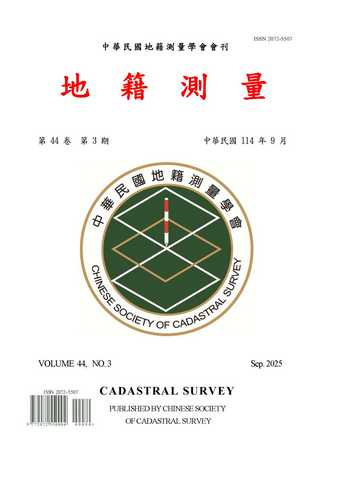 |
 本站僅提供期刊文獻檢索。 本站僅提供期刊文獻檢索。
【月旦知識庫】是否收錄該篇全文,敬請【登入】查詢為準。
 最新【購點活動】 最新【購點活動】
|
| 篇名 |
空間資訊時代基本地形圖應有的變革
|
| 並列篇名 |
Evolution of Topographic Base Map in the Era of Geospatial Information Technology |
| 作者 |
王蜀嘉 |
| 中文摘要 |
由歐洲一些先進國家基本地形圖的發展歷史,可以看出基本地形圖的演進是由徒手繪製到數值式地形圖,再到當今的地形資料庫。這樣的演進完全是受到客觀環境的變遷及用圖者主觀需求所決定。客觀的環境方面包含科技的進步程度及國家的經濟狀況等等,主觀需求則包括用圖者對地圖資訊內容及格式的需求、對決策自動化程度的需求等等。以客觀的環境為例,如果沒有高性能的電腦硬體及繪圖軟體的發展,或是沒有社會經濟力量的支持,就不會有數值地形圖的實現。以用圖者主觀需求為例,如果沒有對空間管理及規劃要更合理、更自動化的期望,就不會有對地圖資訊數值化的需求,更不會有對地形資料庫的需求。我國基本地形圖的發展,受到早年以正射像片圖暫代的影響,圖上的數值式資訊不足,屬先天不良;又受到國家基本圖測繪主管及承辦單位的位階既低且體制又不統一的影響,屬後天失調。未來的發展方向應該跳過先進國家所經過的數值式地形圖發展過程,而直接進入地形資料庫的時代,方能滿足現代的需求。可是由於目前各界對於基本地形圖的需求及目的認知分歧,使得未來發展何去何從,莫衷一是。雖然各國國情及習慣不同,各有各的發展策略,但是有些基本的原則是通用的。本文由德國及英國20多年的發展結果歸納出一些要點,對照目前我國基本地形圖的現況,分析問題的所在,並提出對未來發展的一些建議,供各界參考。
Looking back to the history of the development of national topographical base maps of someleading European countries, we can see that the development of the base maps from paper-printed maps to digital mapping and finally to the current topographical data base system is determined bythe objective environment and the subjective needs of the map users. Objective environment includesthe extent of technology development and the social economy strength. Subjective needs includethe demands of map users about the information contents and data format. Take the objectiveenvironment factors for example, if there were no high performance computer hardware and softwareor no strong social economy as backbone, there would be no development of digital mapping. Fromthe subjective needs side, if no users wished more effective, more automated management of thespatial information, there would be no demands for spatial data base. At the beginning stage, in the1970’s Taiwan chose orthophoto map as national base map for the reason to be able to get as quicklyas possible usable maps for the entire island. The drawback is that there is very little vectorizedinformation or digital information. Later on, despite the rapid growth of national economy strengthand needs for more detailed spatial information, the policy of producing base map has never beenimproved due to the fact that all national mapping agencies are very low-leveled and not unified. Inorder to catch up the newest needs of spatial information, Taiwan should not go through the samedevelopment stages like some leading European countries. Instead, it should jump from theorthophoto map directly to building up a national topographic data base, omitting the stage ofproducing digital maps. But due to very diversified needs from different base map users, the directionto which the base maps will go is still unclear. Although each country has its own tradition andcustoms for making base maps, experience from other countries could not be imported directly, butsome basic principles are rather universal. This paper summarized the experience of the base mapdevelopments in Germany and Great Britain of the last 20 and more years and by comparing it to thecurrent problems in Taiwan, some suggestions to the design of the future base maps were made. |
| 英文摘要 |
Looking back to the history of the development of national topographical base maps of someleading European countries, we can see that the development of the base maps from paper-printed maps to digital mapping and finally to the current topographical data base system is determined bythe objective environment and the subjective needs of the map users. Objective environment includesthe extent of technology development and the social economy strength. Subjective needs includethe demands of map users about the information contents and data format. Take the objectiveenvironment factors for example, if there were no high performance computer hardware and softwareor no strong social economy as backbone, there would be no development of digital mapping. Fromthe subjective needs side, if no users wished more effective, more automated management of thespatial information, there would be no demands for spatial data base. At the beginning stage, in the1970’s Taiwan chose orthophoto map as national base map for the reason to be able to get as quicklyas possible usable maps for the entire island. The drawback is that there is very little vectorizedinformation or digital information. Later on, despite the rapid growth of national economy strengthand needs for more detailed spatial information, the policy of producing base map has never beenimproved due to the fact that all national mapping agencies are very low-leveled and not unified. Inorder to catch up the newest needs of spatial information, Taiwan should not go through the samedevelopment stages like some leading European countries. Instead, it should jump from theorthophoto map directly to building up a national topographic data base, omitting the stage ofproducing digital maps. But due to very diversified needs from different base map users, the directionto which the base maps will go is still unclear. Although each country has its own tradition andcustoms for making base maps, experience from other countries could not be imported directly, butsome basic principles are rather universal. This paper summarized the experience of the base mapdevelopments in Germany and Great Britain of the last 20 and more years and by comparing it to thecurrent problems in Taiwan, some suggestions to the design of the future base maps were made. |
| 起訖頁 |
91-104 |
| 刊名 |
地籍測量 |
| 期數 |
200809 (27:3期) |
| 出版單位 |
中華民國地籍測量學會
|
| 該期刊-上一篇 |
地方政府對國土測繪法實施之因應研究 |
| |
|
新書閱讀
最新影音
優惠活動
|